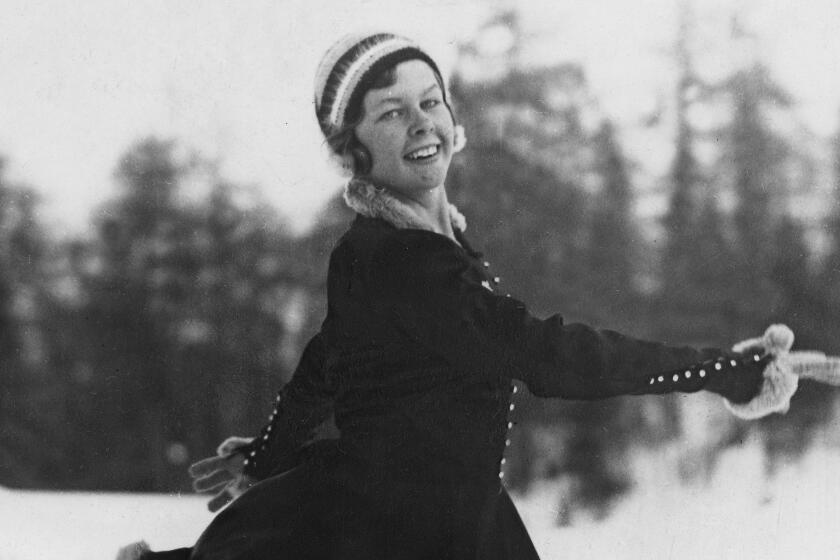Olympic Training Center Will Locate in San Diego
WASHINGTON — The U.S. Olympic Committee’s executive board resoundingly chose San Diego on Friday as home for a new, multimillion-dollar training center that promoters say will finally allow this country’s best amateur athletes to build and polish their skills year-round.
The next hurdle faced by the training center’s local boosters, headed by San Diego Councilwoman Gloria McColl, will be to choose a location from among a number of potential ones. Seven possible sites approved Friday by the Olympic Committee include five private and two public properties ranging in size from 100 to 250 acres. Selection of a site is expected within three months, and the center is to open in late 1991 or 1992.
“It’ll be great. We need someplace to train in a warm climate,” track star Edwin Moses, a delegate to the Olympic Committee meeting here this week, said about the prospect of the first Olympic center west of the Rockies.
Three Other Training Centers
Three other centers now operate in Colorado Springs; Lake Placid, N.Y., and Marquette, Mich. Finding a a warm-weather, year-round training center was ranked in a recent survey of the Olympic Committee as one of the greatest needs facing U.S. athletes bidding for gold in the quadrennial international competition.
“We don’t have enough facilities now in this country, and the guys from New York and the East Coast need a place to train all year,” Moses said in an interview after the San Diego vote. He now trains at UC Irvine, but said he plans to use the San Diego center once it opens.
The center, which calls for an initial local investment of at least $15 million, could prove an economic boon for San Diego, but a task force of local business leaders pushing the project first faces a potential backlash from some communities that have expressed opposition to having the center.
The task force is not disclosing the exact location of the sites under consideration, but some residents near Lake Hodges have already banded together to try to block any move to their North County community.
But, during a press conference upon her return Friday, McColl said Lake Hodges was not one of the sites under consideration because it is too small.
McColl said the task force has identified 10 tracts as potential training-center sites, each of 100 acres or more. Although she declined to give exact locations, McColl said five are in South Bay, three in central San Diego and two in the northern San Diego area.
Organizers say the center’s first phase should cost from $15 million to $18 million--to be paid for from local sources--and will provide housing and dining facilities, an administrative complex, track and field, soccer and other playing fields, an all-purpose gymnasium and a sports medicine facility for about 300 athletes from around the nation.
Plans beyond that first phase are sketchy, but McColl said organizers hope to expand the complex to accommodate up to 1,000 athletes, with a rough final price tag of about $40 million.
Athletes also will be provided with local jobs, and the center is expected to pump money into the community, through its construction and the visitors it will attract.
But local supporters of the center, capping a 3-year effort to bring it to San Diego, downplayed the economics when presenting their proposal to 95 Olympic Committee members gathered in Washington.
“There are very little if any commercial attributes,” said shopping center magnate Ernest Hahn, who sits on the local task force. “It’s the pride in having the facility in our city. That’s the prime motivation.”
McColl was plainly enthusiastic about the decision. “It is good for the U.S., and it is a role model for our local youth,” she said. “Having the facility in our community is going to give the opportunity for the local youth to have a direction in their lives.”
Private Funding
McColl also said the city will not be called upon to pay for the center’s construction. “The private sector is going to pay for building Phase I, and the U.S. Olympic Committee will run it,” she said.
Grumblings about the ease with which San Diego garnered the committee’s vote for the center continued even after the decision, as a few members of the Olympic Committee’s executive board suggested that the site selection panel had gone easy on the city in its review, not demanding sufficient details about the center proposal. But the criticisms focused on the selection process--rather than on the choice of San Diego itself--and critics seemed unwilling to press the issue.
San Diego’s selection as home for the center appeared certain after the Olympic Committee’s site selection panel toured the city’s seven prospective sites earlier this month. The only opposition on the panel came from one member who said San Diego was “rubber-stamped” for the center without serious review of other candidates.
With its mild climate a prominent advantage, San Diego was also aided in its bid by its economy, educational institutions and transportation, site selection panel members indicated.
Indeed, all these factors were cited by the full Olympic Committee Friday as it unanimously named San Diego. The only cautionary note, preceding the decision, was sounded by one delegate who urged center organizers to accommodate Olympic sports that have been neglected at other training sites, such as boating and other water sports.
According to McColl, the training center will be for all athletes, even potential competitors in the luge and bobsled races, who have expressed interest in coming to San Diego because of the budding hi-tech simulator industry.
Times staff writer Ralph Frammolino contributed to this report from San Diego.
More to Read
Go beyond the scoreboard
Get the latest on L.A.'s teams in the daily Sports Report newsletter.
You may occasionally receive promotional content from the Los Angeles Times.






